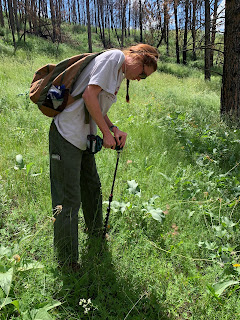Pieces coming together
Post by 2022 student Grace Martin -
For the second portion of the class, we began collecting soil and forage samples so we can later examine them further to look at their composition. We are looking to see how the nutrient composition of the vegetation and soil varies among the different plots. For the soil, we will be sending it off to Montana State University to look further into the microbial population and then do a general soil analysis looking at the amount of nitrogen, phosphorus, etc. To look at the forage, we will be drying the vegetation out. Then we will look at the acid detergent fiber (ADF), neutral detergent fiber (NDF), total digestible nutrients (TDN), dry matter (DM), organic matter (OM), crude protein (CP), and minerals content in the forage. I found this section interesting because I do research on forage analysis at Clemson, so this correlated well.
We first met with Meriel Beck, the Musselshell County Weed Coordinator from Natural Resources Conservation Service (NCRS). She came to talk to us about the importance of weed management and went over the invasive noxious weeds in the area. We quickly realized many plants we had identified in the plot were considered invasive species. It is essential to keep invasive species under control because they can end up outcompeting the native species. When the native species become outcompeted, it can eventually destroy the ecosystem's balance. Some weeds are toxic to cattle, so it is crucial for ranch owners to keep the weeds under control. It is a law in Montana that you are required to manage the weeds on your property. This law is to prevent invasive species from going from one property to another. Meriel works to prevent the spread of invasive species along the roadside of Musselshell County since roads are a primary spreader for them. Weed management uses hand-held sprayers, cars, planes, and even bugs. Much research goes into ensuring the weed killer is safe for native plants and animals. The bugs used in weed management are selected for one plant in particular and will not consume any other species. It can take around ten years for a specific species of a bug to be approved to be used as a form of weed control. I had never really thought of the amount of work and importance that is in weed management, but after talking to Merielle, I realize it is a vital part of ranch management.
We also met with Landon Krogsted from NRCS, who went over the various indicators of rangeland health and how to monitor them. He was able to help us correctly identify some of the grasses and plants we have been struggling with, so that helped a lot with making our data collection much more accurate. Dr. Tom Scott then led the soil collecting section of the class. We used a drill and a very large drill bit to extract the soil from the ground. Once we started gathering soil samples, it was interesting to see how much the soil appearance changed within the same plot. Some sections were very loose and dry, while others remained compact and moist. We sent these samples back with Jeb Eberly from Montana State University Research Center. He will take them to the research center, and DNA will be extracted and examined for each of the plots, and a general soil analysis will be run as well. We will be able to see how the soil types vary between the burned and unburned plots. It will also give us an idea of what type of vegetation is growing in certain soil types.
As we continue to gather data, all the pieces will begin to come together. We will be able to see how all of these components, fire, vegetation, soil, and wildlife, affect one another. The class has flown by, and it is crazy to think we only have one week left. I am excited to start on the last section of the course, wrap up the rest of the data and start analyzing it!



